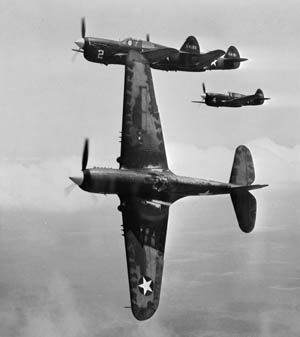Airplanes In My Novels: the Curtiss P-40
Curtiss P-40E pursuits peel off after a target below. USAF photo in the public domain via Wikimedia Commons
Jack Davis flies the Curtiss P-40E in both Everything We Had and the second novel in the series, A Snowball’s Chance, under production as I write this post.
The Curtiss P-40 was America’s front-line pursuit airplane in 1941. It wasn’t as fast or glamorous as the RAF’s Supermarine Spitfire or the Luftwaffe’s Bf-109E. Development of those two airplanes kept them operationally viable through 1945, but the P-40’s performance remained more or less the same from the P-40B through the P-40N. Even changing the Allison V-1710 engine for the Rolls-Royce Merlin in the P-40F didn’t improve that performance. A nearly complete redesign of the P-40, the P-40Q, resulted in an airplane with a top speed of 400 mph, but by then the war was nearly over and the other pursuit types in USAAF service – the P-38, P-47 and P-51, not to mention the first generation of jet fighters like the Lockheed P-80A Shooting Star – were superior in almost every way.
Curtiss P-40B pursuits of the 20th Pursuit Squadron at Nichols Field in the Philippines before the beginning of the war. USAF photo in the public domain via Wikimedia Commons.
The P-40 had two major virtues for a pursuit airplane in 1941 and 1942: first, it was competitive with the Japanese Zero, and second, maybe more important, it was what we had in quantity to equip our own pursuit groups and send overseas to our Allies. In North Africa, the P-40 was used extensively and successfully as a fighter-bomber. In China, the record of the American Volunteer Group (better known as the Flying Tigers) was compiled using a handful of obsolescent P-40B models, the same airplane that equipped the 20th Pursuit Squadron in the Philippines.
The P-40E equipped most of the USAAF pursuit squadrons sent to the Southwest Pacific in 1941 and 1942. For fighting Zeros it was adequate, being as fast as the Zero in level flight and able to break off combat with the Zero by diving away. The Zero wasn’t known for being sturdy, and would come apart under punishment that the P-40, or any other American combat airplane, would simply shrug off.
At the time of Everything We Had, the P-38 was only beginning to become available, and was still overcoming problems associated with compressibility issues at high speeds. The P-38 was the first airplane to encounter Mach buffet, a phenomenon poorly understood in 1941 or for some years afterward. The Republic P-47 Thunderbolt was in development but wouldn’t be available in any numbers until 1943. The P-51 Mustang was originally designed for the RAF as a substitute for the P-40, and was also still in development.
So the P-40 was the only pursuit, other than the Bell P-39 Airacobra, available in any numbers to equip the USAAF. As for the P-39, stay tuned. I’ll talk about that airplane sometime before Christmas, when Boxcar Red Leader, the third book in the series, comes out.
